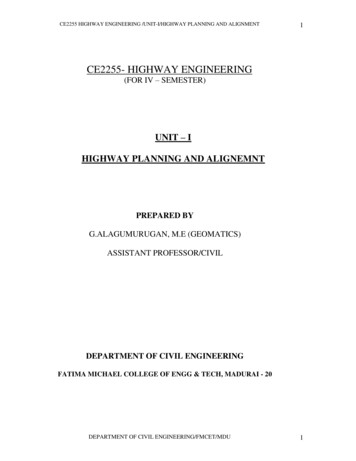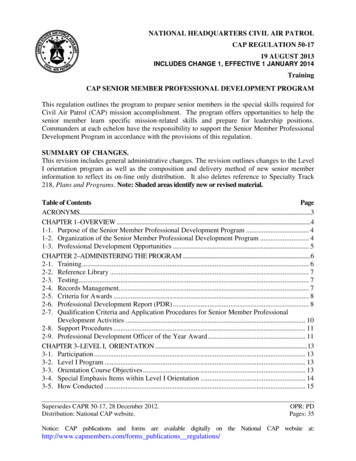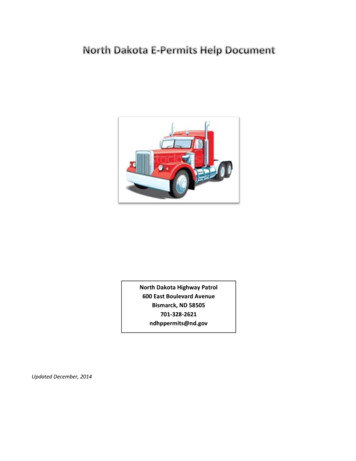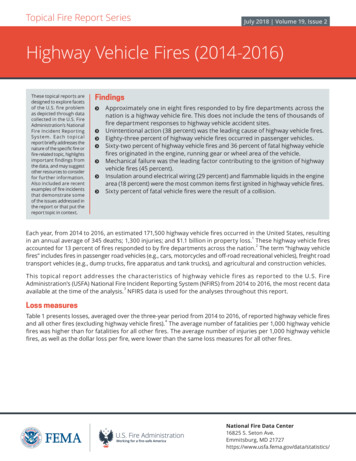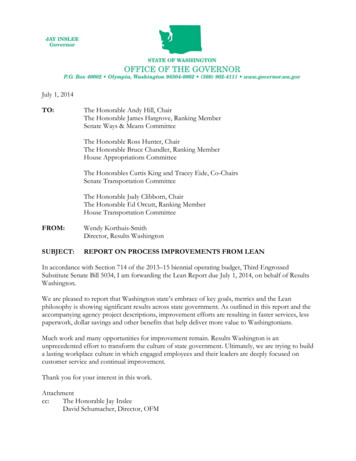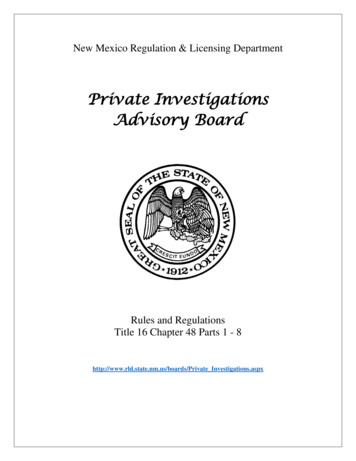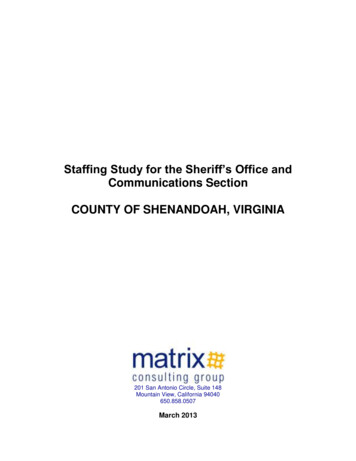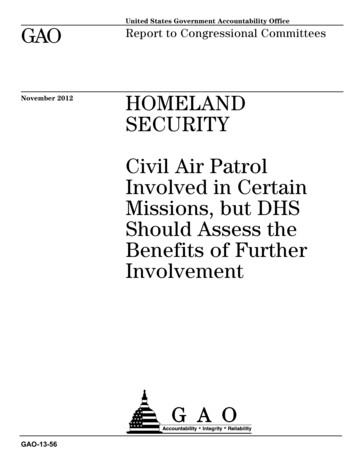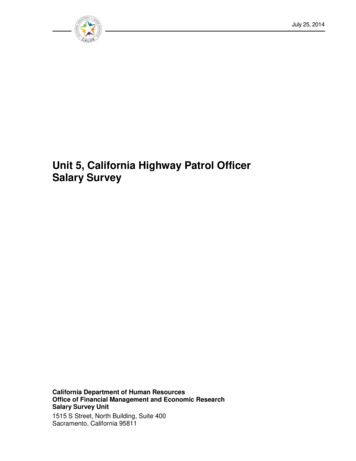
Transcription
July 25, 2014Unit 5, California Highway Patrol OfficerSalary SurveyCalifornia Department of Human ResourcesOffice of Financial Management and Economic ResearchSalary Survey Unit1515 S Street, North Building, Suite 400Sacramento, California 95811
Table of ContentsOverview . 1Labor Agreement Survey Requirement . 1Government Code Section 19827 Survey Requirement . 1Survey Methodology. 12013 Contract Addendum. 32014 Survey Lag Computation . 4Survey Results . 4Description of Survey Process Pursuant to Government CodeSection 19827 . Attachment 1Survey Lag Computation . Attachment 2
OverviewThis salary survey is prepared by the Department of Human Resources pursuant toGovernment Code section 19827 and the bargaining agreement between the State ofCalifornia and the California Association of Highway Patrolmen (union).Labor Agreement Survey RequirementThe labor agreement, also referred to as the Memorandum of Understanding (MOU)between the state and union, has a term of July 3, 2010 through July 3, 2018. The stateis required by Government Code section 19827 and the terms of the MOU to continueproviding California Highway Patrol Officers with general salary increases (GSI) basedupon the lag in this survey.Government Code section 19827 Survey RequirementThe law (Government Code section 19827.) requires the Department and the union tojointly and annually: Survey five specific public law enforcement organizations, and calculate theestimated average total compensation. Conduct the survey using the methodology described in the “Description ofSurvey Process Pursuant to Government Code (Gov. Code, §19827.) Regardingthe Recruitment and Retention of California Highway Patrol Officers” datedJuly 1, 2001. Project the average total compensation ahead to July 1 of the year in which thesurvey is conducted.The law also identifies the components of total compensation to be measured.Survey Methodology—Description of Survey Process Pursuant toGovernment Code section 19827Attachment 1 displays the survey methodology, including the law enforcementorganizations and classifications to be surveyed. The methodology requires: The survey to measure and report on salary range maximum, patrol bonuses,seniority pay (also known as longevity or retention pay), physical performance1
pay, Peace Officer Standards and Training (POST) and other educationincentives, and the employee contribution to retirement1. The use of an average entry age of 24 years, when the employee’s retirementcontribution rate varies based on age in the surveyed organizations. The union is to verify the survey compensation and staffing data collected by theDepartment. The Department and the union will finalize the survey findings by March 31 ofeach year as data is projected to July 1. A labor agreement Side Letter providesthat if an agency for which a projection has been made resolves its contract afterMarch 31 but before the State Controller’s cutoff date for the July pay period,then the survey must be adjusted to reflect the actual figures of the newagreement. The Department to provide survey information on an Excel spreadsheet.The methodology identifies the following surveyed organizations and classifications, andindicates the survey’s intent is to survey the classification that most closely matches theCalifornia Highway Patrol (CHP) Officer, Range A.OrganizationSurveyed ClassificationSan Francisco Police DepartmentPolice Officer Q22San Diego Police DepartmentPolice Officer IILos Angeles County Sheriff’s DepartmentDeputy SheriffLos Angeles Police DepartmentPolice Officer II3Oakland Police DepartmentPolice OfficerCalifornia Highway PatrolCHP Officer, Range A1Government Code section 19827, subdivision (a) (1) requires that total compensation include retirementcontributions made by the employer on behalf of the employee. The Description of the Survey ProcessPursuant to (Gov. Code, § 19827.) does not require that total compensation include retirement contributionsmade by the employer on behalf of the employee. Per past agreement between the union and theDepartment, the survey follows the Description of the Survey Process requirement.2In the Description of the Survey Process Pursuant to (Gov. Code, § 19827.) document, the surveyedclassification is Police Officer III Q4. This is the Police Officer having a POST Advanced Certificate.However, per past agreement between the union and the Department, the surveyed class was changed toPolice Officer Q2, which is the officer having the POST Basic Certificate. To meet the intent of the SurveyMethodology, the Police Officer Q2 more closely matches the California Highway Patrol Officer, Range A.3In the Survey Methodology, the surveyed classification is Police Officer II. However, per past agreementbetween the union and the Department, the weighted average salary is computed based on the combinedcount of Police Officer I, II and III incumbents. The reason is that the Field Training Officer function of thePolice Officer III duties is the same as the Field Training Officer function of the CHP Officer, Range A,duties. The Police Officer III class is an assignment to a higher pay grade for a position carrying greaterresponsibility or requiring greater expertise. The Police Officer I is the cadet class.2
The methodology determines the percent by which the California Highway Patrol Officerweighted total compensation leads or lags the combined, weighted average totalcompensation of the five surveyed organizations.Also included in the methodology is a list of contacts at each jurisdiction. This list hasbeen updated.2013 Contract AddendumAn addendum to the MOU, agreed upon by the state and the union on June 19, 2013,constituted changes to the Bargaining Unit 5 salary survey through June 30, 2018. Thechanges to the survey methodology include the following: The 2.0 percent to the top step salary increase, which was effective January 1,2012, will no longer be excluded from the salary survey starting July 1, 2013. Four percent of the 2013 survey lag will be applied as a general salary increaseon July 1, 2013. The remaining lag (1.9 percent) will be applied to prefund OtherPost-Employment Benefits (OPEB). A simple average of the tiered retirements for each jurisdiction will be used forthe duration of the contract. Employee contributions towards OPEB will not be counted towards the survey for2013-14 for the state or for the surveyed jurisdictions. Beginning July 1, 2014 the2.0 percent employee contribution towards OPEB from CHP officers only will beincluded in the survey until June 30, 2018. Beginning July 1, 2018 the fullemployee OPEB contribution of 3.9 percent will be included in the survey (2.0percent plus the 1.9 percent that was redirected on July 1, 2013). In addition,beginning July 1, 2018, the OPEB contributions paid by the employees in thesurveyed jurisdictions will be considered in the survey.Also agreed upon in this addendum is language extending the 2 percent redirect fromOPEB to the employee contribution towards retirement, as per legislation (Gov. Code, §22944.3.) and 2010-13 MOU Section 42, subdivision (a) (b) for 2013-14 only. Thiscontribution is in addition to the 9.5 percent patrol members are required to pay towardsthe employee contribution to retirement monthly.Per the 2010-13 MOU, effective July 1, 2013, the state will contribute 2 percent towardsOPEB for uniformed CHP members. Effective July 1, 2015, the state will match theadditional 1.9 percent contribution towards OPEB making the total state contribution toOPEB 3.9 percent. State contributions towards OPEB are not reflected in the salarysurvey for the duration of the contract.3
2014 Survey Lag ComputationIn addition to the 2013 Contract Amendment changes to the survey, Attachment 2displays the computation for the CHP Officers’ lag in total compensation behind thesurveyed organizations. The survey methodology is summarized as follows: The survey individually weights the patrol bonus, seniority, physical performance,and education incentive pays for each surveyed organization and for CHPOfficers by the number of officers receiving those incentives in each organization. For the five surveyed organizations as a group, the survey collectively weightsthe patrol bonus, seniority, physical performance, education incentive pay, andmaximum base salary by the total number of officers in the five organizations.The result is the weighted compensation subtotal. For the CHP Officer, the survey combines the maximum salary and weightedincentive pay to determine the weighted compensation subtotal beforesubtracting the contribution toward prefunding employee retiree health and theemployee contribution to retirement. For the five surveyed organizations and the CHP Officer, the survey subtracts theweighted employee contribution to retirement from the compensation subtotalresulting in total compensation. The CHP Officer total compensation and surveyed organizations’ totalcompensation are compared to determine the percent by which the CHP Officerleads or lags the surveyed organizations’ total compensation. A CHP Officer lag, rounded to 1/10th percent, becomes the CHP Officer generalsalary increase effective July 1, 2014.Survey ResultsThe survey resulted in a 6 percent lag for the CHP Officers, which means that CHPOfficers total compensation is currently below the weighted average total compensationof the surveyed organizations.4
Attachment 1July 1, 2001Description of Survey ProcessPursuant to Government Code Section 19827 Regardingthe Recruitment and Retention of California HighwayPatrol (CHP) OfficersDepartment of Personnel AdministrationPolicy Development Office1515 S Street, North Building, Suite 400Sacramento, California 95814Contents:Executive Summary of ng Compensation Items To Be SurveyedstSurvey Estimates To July 1Use Of Weighted Average And Additional InformationSurvey Contact List–ManagementSurvey Contact List–LaborSurvey Data SheetAttachment AAttachment BEnclosed
Attachment 1Executive Summary of ProcessExecutive SummaryThis document presents the survey methodology and process for the Department ofPersonnel Administration's survey of five jurisdictions pursuant to Government Codesection 19827. In addition, this methodology and process is to be used for any futuresurveys performed under this section.Government Jurisdictions Surveyed for Job Matches: San Francisco CityCity of San DiegoLos Angeles CountyCity of Los AngelesCity of OaklandCompensation Items to be Surveyed: Salary Range MaximumPatrol BonusesSeniority PayPhysical Performance PayPost/Education IncentivesEmployee Contribution to RetirementSurvey Timing and Effective DateThe parties will finalize survey findings prior to March 31st of each year. PerGovernment Code section 19827, survey data is projected to July 1st.Use of Weighted AverageCalculations use numbers of employees receiving compensation multiplied by theamount paid and divided by the survey population to produce the “weighted average.”
Attachment 1Introduction/BackgroundThis survey is produced by the Department of Personnel Administration, in cooperationwith the California Association of Highway Patrolmen (CAHP) pursuant to:Government Code section 19827: (a) In order for the State to recruit and retain thehighest qualified employees for the California Highway Patrol, it is the policy of theState to compensate State traffic officers the estimated average total compensationas of July 1 of the year in which comparisons are made for the rank corresponding toState traffic officer within the Los Angeles Police Department, Los Angeles CountySheriff's Office, San Diego Police Department, Oakland Police Department, and theSan Francisco Police Department. Total compensation includes, but is not limited to,salary, retirement, health and dental insurance, educational incentives, longevity pay,night shift differential, and other skill or incentive pay. Any increase in totalcompensation resulting from this subdivision shall be implemented through amemorandum of understanding negotiated pursuant to the Ralph C. Dills Act(Chapter 10.3 [commencing with Section 3512] of Division 4 of Title 1). If theprovisions of this subdivision are in conflict with the provisions of a memorandum ofunderstanding reached pursuant to Section 3517.5, the memorandum ofunderstanding shall be controlling without further legislative action, except that if theprovisions of a memorandum of understanding require the expenditure of funds, theprovisions shall not become effective unless approved by the Legislature in theannual Budget Act. (b) When determining compensation for State excluded swornclassifications of the California Highway Patrol, it is the policy of the State to considertotal compensation for corresponding ranks within jurisdictions specified insubdivision (a), as well as other factors, including internal comparisons.MethodologyThe survey considers salary rates paid to rank and file officers in five California localgovernments, law enforcement agencies: San Francisco City Police, City of San DiegoPolice, Los Angeles County Sheriff's Office, City of Los Angeles Police, and City ofOakland Police. Both the Department of Personnel Administration and the CAHP haveaccess to information and agree to cooperate in the collection and analysis of datanecessary to complete this survey. The parties may review these job matches from timeto time, but it is the intent of the parties to utilize the classification in the jurisdiction thatmost closely matches the "CHP Officer, Range A." The surveyed classes in the localgovernment jurisdictions are currently San Francisco City - “Q-4” classification; SanDiego City - “PO II” classification; Los Angeles County - "Deputy Sheriff” classification;Los Angeles City - “PO II” classification; and City of Oakland - “Police Officer”classification.Identifying Compensation Items to be SurveyedIn determining 2001 survey findings, the DPA studied compensation items paid to CHPofficers and officers in the survey jurisdictions. The DPA and CAHP determined that thesignificant items to be measured and reported were base salary, patrol and incentivebonuses, seniority pay, physical performance pay, POST and other educationincentives, and employee contribution to retirement. The parties agree that any pay orincentive items added to the survey must be significant items in order to be reported inthe survey. In the original study, some items were studied but not reported due to thedirect comparability of the items between jurisdictions or that there was de minimuseffect of those items.
Attachment 1Survey Estimates to July 1stThe parties will finalize survey findings prior to March 31st of each year as data isprojected to July 1st.The parties may also provide periodic survey updates thereafter andmeet to review findings. Projected figures will take into account salary scheduleadjustments occurring on July 1st or during that fiscal year. As an example, if a 4percent adjustment is to be granted on July 1st, and another 4 percent adjustment onJanuary 1st, then the total impact of the increases for the fiscal year would be 6 percent.This annualized change is based on the 4 percent on January 1st being an annualized 2percent base salary increase. This annualized 2 percent, when added to the 4 percentincrease on July 1st increase, brings the total annualized increase to 6 percent. In theevent that a jurisdiction is in the process of negotiating economic terms, the parties mayuse reasonable projection methods including past history of the jurisdictions andreasonable estimates of anticipated settlements.Use of Weighted Average and Additional InformationIn reporting data, survey information will be provided by the DPA on an "Excel"spreadsheet using a format provided by the Office of Financial Management, DPA. Thespreadsheet enclosed with this report shall be the format for presenting survey findingsunder this section. Further, various worksheets for the determination of various specialpay items actually included in the survey findings will be documented on a "Word"format. Agreements reached by jurisdictions engaged in negotiations prior to July 1stwould be taken into account.The DPA will collect compensation and staffing data from the jurisdictions and from theState Controllers' Office (SCO) and the CHP, Office of Labor Relations for CHP Officers.Data will be provided to CAHP and verified. In turn, CAHP will provide salary rates andincentive pays for each jurisdiction based on information provided by the unions andtheir respective MOUs. The DPA will confirm these figures. Calculations will use thenumbers of employees receiving compensation items surveyed multiplied by the amountpaid and divided by the survey population to produce the “weighted average.”Salary will be determined by utilizing the top step of the surveyed class in eachjurisdiction. Incentive pays will then be added to arrive at a subtotal for compensationbefore subtracting the employee’s contribution to retirement. In jurisdictions where theemployee’s retirement contribution varies based on age, an average entry age of 24years will be utilized.
Attachment 1Attachment AList of Contacts, Government EmployersBelinda ChinCity & County of San FranciscoSan Francisco Police DepartmentPayroll Manager850 Bryant Street, Suite 513San Francisco, Ca 94103415.553.9169; Fax: 415.557.4919Belinda.Chin@sfgov.orgDarren KeenaghanCity of San DiegoSupervising Personnel AnalystPersonnel Department1200 Third Ave, Suite 300San Diego, CA 92101619.236.7048; Fax: 619.236.5515Main Number 619.236.6400DKeenaghan@sandiego.govKristi MinorLos Angeles CountySenior Departmental Personnel TechnicianLos Angeles County’s Sheriff’s DepartmentPersonnel Administration – Classifications Unit11515 S. Colima, C-104Whittier, CA 90604562.903.7546; Fax: 323.415.2725KmMinor@lasd.orgMaritta AspenCity of Los AngelesActing Division ChiefCAO, Employee Relations Division220 N. Main Street Los Angeles, Ca 90012213.978.7641; Fax: 213.978.7613Maritta.Aspen@lacity.orgPenny HaCity of OaklandSupport Services SupervisorPolice Personnel Division150 Frank H. Ogawa Plaza, 3rd FloorOakland, Ca 94612-2019510.238.3733; Fax 510.238.7197PHa2@oaklandnet.com
Attachment 1Attachment BList of Contacts, Labor OrganizationsAssociation of Los Angeles Deputy Sheriffs800.452.5237Los Angeles Police Protective League213.251.4554Oakland Police Officers Association510.834.9670San Diego Police Officers Association858.573.1199San Francisco Police Officers Association415.861.5060
Attachment 2California Highway Patrol Five- Jurisdiction SurveyProjected to July 1, 2014, - Survey Lag ComputationCalifornia Highway Patrol Five - 2014 - Survey Lag ComputationMax.RatePatrolIncentiveWeighted byOfficersReceivingDifferentialSeniority PayWeighted byOfficersReceivingDifferentialPOST/Ed. Diff.AveragePhysicalPerformPay (PPP)Total ofPatrol Seniority POST/Ed PPPPaysSalary PatrolSeniority POST/Ed PhysicalEmployeeRet.Contrib.RateEmployeeRet. CostEmployeeContrib.to RetireeHealthEmployeeRetireeHealth CostNet Pay1,605 9,347 0 33 342 0 374 9,72112.67% 1,2310.00% 0 8,490San DiegoP.D.1,014 6,350 153 0 403 0 556 6,90612.67% 875NANA 6,031L.A.CountySheriff7,489 6,841 31 104 667 0 801 7,6429.58% 732NANA 6,911L.A. CityP.D.6,833 7,369 157 206 97 0 460 7,8298.00% 6260.00% 0 7,203City ofOaklandP.D.457 8,421 58 98 228 0 384 8,8059.00% 792NANA 8,013SurveyTotal17,398 7,292 85 131 386 0 603 7,895 0 7,149CHP Off.,(A)6,289 7,284 0 59 219 108 387 7,670 146 ciscoP.D. 74611.50% 7832.00%Projected Lag at 7/1/146.04%Per MOU, 100% of the lag at 7-1-14 provides a general salary increase of6.0%
changes to the survey methodology include the following: The 2.0 percent to the top step salary increase, which was effective January 1, 2012, will no longer be excluded from the salary survey starting July 1, 2013. Four percent of the 2013 survey lag will be applied as a general salary increase on July 1, 2013.

